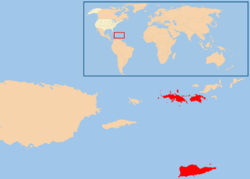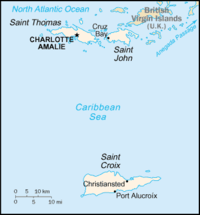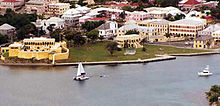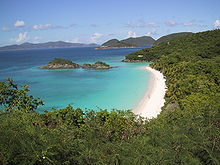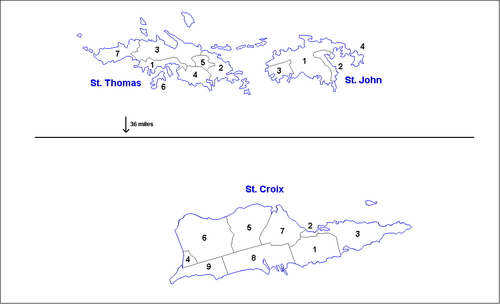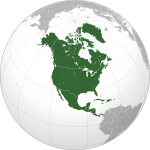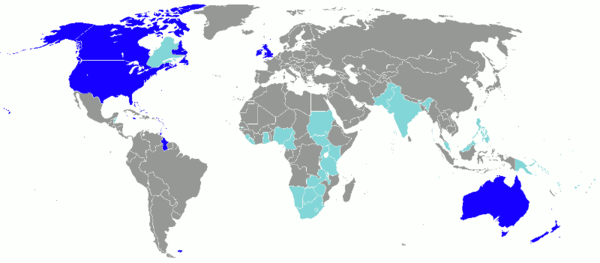- United States Virgin Islands
-
Virgin Islands of the United States 

Flag Coat of arms Motto: United in Pride and Hope Anthem: "Virgin Islands March" Capital
(and largest city)Charlotte Amalie
18°21′N 64°56′W / 18.35°N 64.933°WOfficial language(s) English Ethnic groups black 76.2%, white 13.1%, Asian 1.1%, other 6.1%, mixed 3.5%[1] Demonym US Virgin Islander Government Unincorporated, organized territory - President Barack Obama (D) - Governor John de Jongh (D) - Lieutenant Governor Gregory R. Francis (D) U.S territory - Treaty of the Danish West Indies March 31, 1917 - Revised Organic Act July 22, 1954 Area - Total 346.36 km2 (202nd)
133.73 sq mi- Water (%) 1.0 Population - 2010 census 109,750 - Density 354/km2 (34th)
916.9/sq miGDP (PPP) 2003 estimate - Total $1.577 billion Currency US$ ( USD)Time zone AST (UTC−4) - Summer (DST) No DST (UTC−4) Drives on the left[2] ISO 3166 code US-VI Internet TLD .vi and .us Calling code +1 (spec. +1-340) The Virgin Islands of the United States (commonly called the United States Virgin Islands, U.S. Virgin Islands or USVI) are a group of islands in the Caribbean that are an insular area of the United States. The islands are geographically part of the Virgin Islands archipelago and are located in the Leeward Islands of the Lesser Antilles.
The U.S. Virgin Islands consist of the main islands of Saint Croix, Saint John, and Saint Thomas, along with the much smaller but historically distinct Water Island, and many other surrounding minor islands. The total land area of the territory is 133.73 square miles (346.4 km2).
As of the 2000 census the population was 108,612,[3] mostly composed by those of Afro-Caribbean descent. Tourism is the primary economic activity, although there is a significant manufacturing sector.
Formerly the Danish West Indies, they were sold to the United States by Denmark in the Treaty of the Danish West Indies of 1916. They are classified by the UN as a Non-Self-Governing Territory, and are currently an organized, unincorporated United States territory. The U.S. Virgin Islands are organized under the Revised Organic Act of 1954, and have since held five constitutional conventions. The last proposed Virgin Islands Constitution of 2009 was addressed by Congress in 2010 and sent back to the territory, where the convention will reconvene in the near future to address the concerns Congress has had with the proposed document.
Contents
History
The Virgin Islands were originally settled by the Ciboney, Carib, and Arawaks. The islands were named by Christopher Columbus on his second voyage in 1493 for Saint Ursula and her virgin followers. Over the next two hundred years, the islands were held by many European powers, including Spain, the United Kingdom, the Netherlands, France, and Denmark-Norway.
The Danish West India Company settled on Saint Thomas in 1672, on Saint John in 1694, and purchased Saint Croix from France in 1733.[citation needed] The islands became royal Danish colonies in 1754, named the Danish-Westindian islands (Danish: De dansk-vestindiske øer).[4] Sugarcane, produced by slave labor, drove the islands' economy during the 18th and early 19th centuries, until the abolition of slavery by Governor Peter von Scholten on July 3, 1848.
For the remainder of the period of Danish rule, the islands were not economically viable and significant transfers were made from the Danish state budgets to the authorities in the islands. In 1867 a treaty to sell Saint Thomas and Saint John to the United States was agreed, but the sale was never effected.[5] A number of reforms aimed at reviving the islands' economy were attempted, but none had great success. A second draft treaty to sell the islands to the United States was negotiated in 1902 but was narrowly defeated in the Danish parliament.[5]
The onset of World War I brought the reforms to a close and again left the islands isolated and exposed. During the submarine warfare phases of the First World War, the United States, fearing that the islands might be seized by Germany as a submarine base, again approached Denmark with a view to buying them. After a few months of negotiations, a selling price of $25 million (This is equivalent to $428,000,000 in 2010 dollars[6]) was agreed.[citation needed] At the same time the economics of continued possession weighed heavily on the minds of Danish decision makers, and a bipartisan consensus in favor of selling emerged in the Danish parliament.
The Treaty of the Danish West Indies was signed in August 1916,[7] with a Danish referendum held in December 1916 to confirm the decision. The deal was finalized on January 17, 1917, when the United States and Denmark exchanged their respective treaty ratifications. The US took possession of the islands on March 31, 1917 and the territory was renamed the Virgin Islands of the United States.[citation needed] US citizenship was granted to the inhabitants of the islands in 1927.
Water Island, a small island to the south of Saint Thomas, was initially administered by the US federal government and did not become a part of the U.S. Virgin Islands territory until 1996, when 50 acres (200,000 m2) of land was transferred to the territorial government. The remaining 200 acres (81 ha) of the island were purchased from the U.S. Department of the Interior in May 2005 for $10, a transaction which marked the official change in jurisdiction.[8]
Geography
The US Virgin Islands are in the Caribbean Sea and the Atlantic Ocean, about 40 miles (64 km) east of Puerto Rico and immediately west of the British Virgin Islands. The territory consists of four main islands: Saint Thomas, Saint John, Saint Croix, and Water Island, as well as several dozen smaller islands. The main islands have nicknames often used by locals: "Twin City" (St. Croix), "Rock City" (St. Thomas) and "Love City" (St. John).[9] The combined land area of the islands is roughly twice the size of Washington, D.C.
The US Virgin Islands are known for their white sand beaches, including Magens Bay and Trunk Bay, and strategic harbors, including Charlotte Amalie and Christiansted. Most of the islands, including Saint Thomas, are volcanic in origin and hilly. The highest point is Crown Mountain, Saint Thomas (1,555 ft/474 m). Saint Croix, the largest of the US Virgin Islands, lies to the south and has a flatter terrain. The National Park Service owns more than half of Saint John, nearly all of Hassel Island, and many acres of coral reef. (See also Virgin Islands National Park, Virgin Islands Coral Reef National Monument, Buck Island Reef National Monument, Christiansted National Historic Site, and Salt River Bay National Historical Park and Ecological Preserve.)
The Virgin Islands lie on the boundary of the North American plate and the Caribbean Plate. Natural hazards include earthquakes and tropical cyclones (including hurricanes).
Climate
Main article: Climate of the United States Virgin IslandsClimate data for Saint Thomas, VI Month Jan Feb Mar Apr May Jun Jul Aug Sep Oct Nov Dec Year Record high °F (°C) 93
(34)93
(34)94
(34)96
(36)97
(36)99
(37)98
(37)99
(37)98
(37)97
(36)95
(35)92
(33)99
(37)Average high °F (°C) 86
(30)86
(30)86
(30)88
(31)88
(31)90
(32)90
(32)91
(33)90
(32)90
(32)88
(31)86
(30)88 Average low °F (°C) 72
(22)72
(22)72
(22)74
(23)76
(24)77
(25)78
(26)78
(26)77
(25)76
(24)75
(24)73
(23)75 Record low °F (°C) 63
(17)62
(17)56
(13)62
(17)66
(19)67
(19)57
(14)59
(15)64
(18)66
(19)52
(11)62
(17)52
(11)Precipitation inches (mm) 1.89
(48)1.51
(38.4)1.52
(38.6)2.39
(60.7)3.36
(85.3)2.35
(59.7)2.42
(61.5)3.50
(88.9)5.34
(135.6)5.57
(141.5)5.28
(134.1)2.74
(69.6)37.8
(960)Source: weather.com[10] Politics
The U.S. Virgin Islands are an organized, unincorporated United States territory. Even though they are U.S. citizens, U.S. Virgin Islands residents cannot vote in presidential elections. U.S. Virgin Islands residents, however, are able to vote in presidential primary elections for delegates to the Democratic National Convention and the Republican National Convention.
The main political parties in the U.S. Virgin Islands are the Democratic Party of the Virgin Islands, the Independent Citizens Movement, and the Republican Party of the Virgin Islands. Additional candidates run as independents.
At the national level, the U.S. Virgin Islands elect a delegate to Congress from their at-large congressional district. However, the elected delegate, while able to vote in committee, cannot participate in floor votes. The current House of Representatives delegate is Donna Christensen (D).
At the territorial level, 15 senators—seven from the district of Saint Croix, seven from the district of Saint Thomas and Saint John, and one senator at-large who must be a resident of Saint John—are elected for two-year terms to the unicameral Virgin Islands Legislature.
The U.S. Virgin Islands have elected a territorial governor every four years since 1970. Previous governors were appointed by the President of the United States.
The U.S. Virgin Islands have a District Court, Superior Court and the Supreme Court. The District Court is responsible for federal law, while the Superior Court is responsible for U.S. Virgin Islands law at the trial level and the Supreme Court is responsible for appeals from the Superior Court for all appeals filed on or after January 29, 2007. Appeals filed prior to that date are heard by the Appellate Division of the District Court. Appeals from the federal District Court are heard by the United States Court of Appeals for the Third Circuit, located in Philadelphia, Pennsylvania. District Court judges are appointed by the President, while Superior Court and Supreme Court judges are appointed by the Governor.
Self-determination
The U.S. Virgin Islands are on the United Nations list of Non-Self-Governing Territories. A 1993 referendum on status attracted only 31.4% turnout, and so its results (in favor of the status quo) were considered void. No further referenda have been scheduled since.
In 2004, the 25th legislature established the Fifth Constitutional Convention. In June 2009, Governor John deJongh, Jr. rejected the resulting draft constitution, saying that the document "violates federal law, fails to defer to federal sovereignty and disregards basic civil rights".[11] However, a lawsuit filed by members of the Fifth Constitutional Convention to force Governor deJongh to forward the document to President Barack Obama was ultimately successful. The president forwarded the proposal to Congress—which then had 60 days to approve or reject the document—in May 2010, along with a report noting concerns raised by the Justice Department and restating the issues noted by Governor deJongh. A Congressional resolution disapproving of the proposed constitution and requesting that the Fifth Constitutional Convention reconvene to consider changes to address these issues was signed into law by President Obama on June 30, 2010.[12][13]
There is a bill pending Senate approval in the United States Congress that would lift the ban[clarification needed] and thus authorize the United States Secretary of the Interior to extend technical assistance grants and other assistance to facilitate a political status public education program in the US Virgin Islands, Guam and American Samoa.[14]
A federal lawsuit in the District Court of the Virgin Islands is currently pending to provide Virgin Islanders with the fundamental right to be represented in Congress and vote for U.S. President. The case is Civil No. 3:11-cv-110, Charles v. U.S. Federal Elections Commission. The case alleges it was racial discrimination present in a all white and segregated Congress of 1917 that was the impetus to deny the right to vote to a majority non-white constituency.
Economy
Tourism is the primary economic activity. The islands normally host 2 million visitors a year, many of whom visit on cruise ships.
The manufacturing sector consists of petroleum refining, textiles, electronics, rum distilling, pharmaceuticals, and watch assembly. The agricultural sector is small, with most food being imported. International business and financial services are a small but growing component of the economy. Hovensa, one of the world's largest petroleum refineries, is located on Saint Croix.
The U.S. Virgin Islands are located in the Atlantic Standard Time zone and do not participate in daylight saving time. When the mainland United States is on Standard Time, the U.S. Virgin Islands are one hour ahead of Eastern Standard Time. When the mainland United States is on daylight saving time, Eastern Daylight Time is the same as Atlantic Standard Time.
Demographics
Historical populations Year Pop. ±% 1970 62,468 — 1980 96,569 +54.6% 1990 101,809 +5.4% 2000 108,612 +6.7% 2010 106,405 −2.0% As of the census[15] of 2010, there were 106,405 people,[16] 40,648 households, and 26,636 families residing in the territory. The racial makeup of the territory was 76.2% Black or African Descent, 13.1% White, 6.1% from other races, 1.1% Asian and 3.5% from two or more races. Hispanic or Latino of any race were 18.6% of the population. Most Hispanics are of Puerto Rican descent, however there also is a smaller Dominican population.
There were 40,648 households out of which 34.7% had children under the age of 18 living with them, 33.2% were married couples living together, 24.9% had a female householder with no husband present, and 34.5% were non-families. 30.2% of all households were made up of individuals and 6.3% had someone living alone who was 65 years of age or older. The average household size was 2.64 and the average family size was 3.34.
In the territory the population was spread out with 31.6% under the age of 18, 8.0% from 18 to 24, 27.1% from 25 to 44, 24.9% from 45 to 64, and 8.4% who were 65 years of age or older. The median age was 33 years. For every 100 females there were 91.4 males. For every 100 females age 18 and over, there were 87.7 males. The annual population growth is −0.12%.
The median income for a household in the territory was $24,704, and the median income for a family was $28,553. Males had a median income of $28,309 versus $22,601 for females. The per capita income for the territory was $13,139. About 28.7% of families and 32.5% of the population were below the poverty line, including 41.7% of those under age 18 and 29.8% of those age 65 or over.
Ethnicity
Most US Virgin Islanders descend from Africans, who were enslaved and brought to the Caribbean by Europeans to labor on sugar plantations. Most of the residents were born in the islands, although many migrated to the U.S. Virgin Islands from other islands in the West Indies, the United States and other countries.[citation needed]
Language
The official language is English, although Virgin Islands Creole, an English-based dialect, is spoken in informal situations. The Virgin Islands Creole spoken on St. Croix, known as Crucian, is slightly different from that spoken on St. Thomas and St. John. Because the U.S. Virgin Islands are home to thousands of immigrants from across the Caribbean, Spanish and various French creole languages are also widely spoken. As of the 2000 census, 25.3% of persons over the age of five speak a language other than English at home.[17]
Religion
As in most Caribbean countries, Christianity is the dominant religion in the Virgin Islands. In a reflection of the territory's Danish colonial heritage, Protestantism is most prevalent.[citation needed] There is also a strong Roman Catholic presence.[citation needed]
Culture
Districts and sub-districts
The US Virgin Islands are administratively divided into three districts and subdivided into 20 sub-districts.
The districts are:
Sub-districts of Saint Croix:
- Anna's Hope Village
- Christiansted
- East End
- Frederiksted
- Northcentral
- Northwest
- Sion Farm
- Southcentral
- Southwest
Sub-districts of Saint Thomas:
- Charlotte Amalie
- East End
- Northside
- Southside
- Tutu
- Water Island
- West End
Sub-districts of Saint John:
Transportation and communications
The Henry E. Rohlsen International Airport serves St. Croix and the Cyril E. King International Airport serves St. Thomas and St. John. The U.S. Virgin Islands are the only United States territory which drives on the left. This was inherited from what was then-current Danish practice at the time of annexation, to limit losses of livestock. However, as most cars being imported from the mainland United States are left-hand drive, the driver sits to the outside of the road, raising traffic safety issues.
U.S. Virgin Islands mail service is handled by the United States Postal Service, using the two-character state code "VI" for domestic mail delivery.[18][19][20] Zip codes are in the 008xx range.[20] As of January 2010[update], specifically assigned codes include 00801-00805 (St Thomas),[21] 00820-00824 (Christiansted),[22] 00830-00831 (St John),[23] 00840-00841 (Frederiksted),[24] and 00850-00851 (Kingshill).[25] The islands are part of the North American Numbering Plan, using area code 340, and island residents and visitors are able to call toll-free U.S. numbers.[18]
Education
The Virgin Islands Department of Education serves as the territory's education agency, and has two school districts: St. Thomas-St. John School District and St. Croix School District.[26]
The University of the Virgin Islands provides higher education leading to associate's, bachelor's, and master's degrees, with campuses on St. Thomas and St. Croix.
Holidays
- January - (1st) New Years Day, Martin Luther King, Jr. Day
- February - (14th) Valentine's Day, President's Day (note: The Agriculture Fair occurs on this weekend)
- March - (31st) Transfer Day
- April - Easter, St. Thomas Carnival
- May - Memorial Day
- July - (3rd) Emancipation Day, (4th) Independence Day (St. John Festival is held on both days)
- September - Labor Day, (11th) 9/11 Remembrance
- October - Virgin Islands Puerto Rico Friendship Day/Columbus Day
- November - (1st) David Hamilton Jackson Day also known as Bull and Bread Day, (11th) Veteran's Day, Thanksgiving Day
- December - (24th-25th) Christmas Eve and Christmas, Crucian Festival (continues in January)
See also
- Outline of the United States Virgin Islands
- Bibliography of the United States Virgin Islands
- Index of United States Virgin Islands-related articles
- Caribbean Sea
- Leeward Islands
- List of National Register of Historic Places in the United States Virgin Islands
- List of people from the United States Virgin Islands
- Virgin Islands
- Territories of the United States
References
- ^ [1]
- ^ Only US dependency to drive on the left.
- ^ 2000 Population Counts for the U.S. Virgin Islands, U.S. Census Bureau.
- ^ Danish Wikipedia entry.
- ^ a b A Brief History of the Danish West Indies, 1666–1917, Danish National Archives
- ^ Consumer Price Index (estimate) 1800–2008. Federal Reserve Bank of Minneapolis. Retrieved December 7, 2010.
- ^ Convention between the United States and Denmark for cession of the Danish West Indies, 39 Stat. 1706
- ^ Poinski, Megan. "Water Island appears frozen in time, but big plans run under the surface – V.I. says land acquired from the feds is about to undergo large-scale improvements". The Virgin Islands Daily News, November 18, 2005, online edition. Retrieved September 6, 2007.
- ^ Slawych, Diane. "Love is in the air". CANOE.ca. http://travel.canoe.ca/Travel/Activities/Romantic/2004/02/11/343943.html. Retrieved January 25, 2008.
- ^ "Average Conditions Saint Thomas, VI". weather.com. http://www.weather.com/outlook/travel/businesstraveler/wxclimatology/monthly/00801. Retrieved May 16, 2010.
- ^ Poinski, Megan, "Governor Rejects Constitution Draft", article in The Virgin Islands Daily News, June 13, 2009. Retrieved July 29, 2009.
- ^ Office of the White House Press Secretary (June 30, 2010). "Statement by the Press Secretary on S.J.Res. 33". http://www.whitehouse.gov/the-press-office/statement-press-secretary-sjres-33. Retrieved June 30, 2010.
- ^ "USVI Constitutional Convention mandated to reconsider autonomous proposals". Virgin Islands News Online. June 30, 2010. http://www.virginislandsnewsonline.com/news/usvi-constitutional-convention-mandated-reconsider-autonomous-proposals.
- ^ Overseas Review, "US House Approves Political Status Education Bill"
- ^ "American FactFinder". United States Census Bureau. http://factfinder.census.gov. Retrieved 2008-01-31.
- ^ http://2010.census.gov/news/releases/operations/cb11-cn180.html
- ^ Detailed Tables – American FactFinder United States Census Bureau. Retrieved January 11, 2011.
- ^ a b "Virgin Islands Tourist Tips". Here.VI Search. WebMastersVI.com. http://www.here.vi/Tourist_Tips/tourist_tips.html. Retrieved January 24, 2010.
- ^ "Official USPS Abbreviations". United States Postal Service. http://www.usps.com/ncsc/lookups/usps_abbreviations.html. Retrieved January 24, 2010.
- ^ a b "Virgin Islands General Information". United States Postal Service. http://www.usps.com/ncsc/addressstds/vigeninfo.htm. Retrieved January 24, 2010.
- ^ "St Thomas, VI". Zip-Codes.com. Datasheer, LLC. http://www.zip-codes.com/city/VI-ST-THOMAS.asp. Retrieved January 24, 2010.
- ^ "Christiansted, VI". Zip-Codes.com. Datasheer, LLC. http://www.zip-codes.com/city/VI-CHRISTIANSTED.asp. Retrieved January 24, 2010.
- ^ "St John, VI". Zip-Codes.com. Datasheer, LLC. http://www.zip-codes.com/city/VI-ST-JOHN.asp. Retrieved January 24, 2010.
- ^ "Frederiksted, VI". Zip-Codes.com. Datasheer, LLC. http://www.zip-codes.com/city/VI-FREDERIKSTED.asp. Retrieved January 24, 2010.
- ^ "Kingshill, VI". Zip-Codes.com. Datasheer, LLC. http://www.zip-codes.com/city/VI-KINGSHILL.asp. Retrieved January 24, 2010.
- ^ "Home." U.S. Virgin Islands Department of Education. Retrieved October 13, 2010. Go to the "Schools" tab and two school districts are listed.
External links
- Official Tourism Website
- Governor's Website
- Office of the Lieutenant Governor
- Virgin Islands entry at The World Factbook
- U.S. Census Bureau: Island Areas Census 2000
- United States Virgin Islands from UCB Libraries GovPubs
- United States Virgin Islands at the Open Directory Project
- Wikimedia Atlas of the United States Virgin Islands
- Virgin Islands travel guide from Wikitravel
- Real-time, geographic and other scientific resources of Virgin Islands from the United States Geological Survey
- Convention between the United States and Denmark for cession of the Danish West Indies
- Official Website of St. Thomas and St. John This Week Magazine – Tourist Information for St. Thomas and St. John
- Official Website of St. Croix This Week Magazine – Tourist Information for St. Croix
- Official Website of Virgin Voice Magazine for United States Virgin Islands – Lifestyle, Culture & Commerce Information for All Islands
 Territory of United States Virgin Islands
Territory of United States Virgin IslandsTopics - Geography
- Economy
- Demographics
- Communications
- Transportation
- History
- Visitor Attractions
Government - Politics
- Governors
- Congressional Delegates
- Senators
- Elections
Cities Islands Parks Categories:- United States Virgin Islands
- Lesser Antilles
- Caribbean countries
- Dependent territories in North America
- Virgin Islands
- English-speaking countries and territories
- Insular areas of the United States
- Caribbean islands of the United States
- Divided regions
- Former Danish colonies
- States and territories established in 1917
- Island countries
Wikimedia Foundation. 2010.

